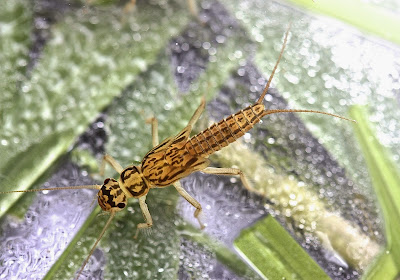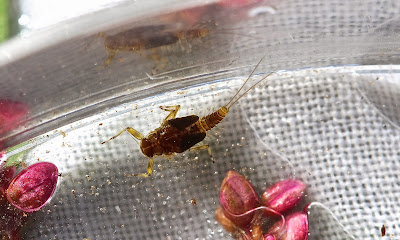Saturday, November 2, 2013
More "small beginnings" at the Rapidan River: the first Lepidostomatids and Isoperla Montanas
I didn't expect to see these little case-makers this early -- but I think the same thing happened last year, also at the Rapidan River. This is the case-maker, Lepidostomatid (genus Lepidostoma) -- "Scaly-mouth caddisfly" -- that we find in small, forested mountain streams. They often start to make their cases out of sand grains then switch over to evenly cut sections of leaves, making a four-sided case. In the winter, we often see nothing but the four-sided cases, but some seem to hang on to the "mixed media" case, like this larva I found on 1/14 of this year.
I found three cases today, all of them occupied, and all of them small, ranging from 2.5 mm to 4.5 mm. I had trouble getting clear photos with them sticking their heads out of their cases.
_________________
And then there was this tiny Perlodid stonefly...
which is actually something I was hoping to find. Looking back through my records, I notice that I first spotted this species on November 2nd (!) last year, also at the Rapidan River. At the time I wasn't really sure what it was. But come December, these little nymphs were showing their colors and patterns:
The stripes on the abdomen, the dark transverse band on the head, and the dark bands extending back from that band to the back of the edge of the head, give it away -- Isoperla montana. We'll have to wait for March and April to see how beautiful these stoneflies can be.
________________
I saw the usual, seasonal insects, at the Rapidan River today -- Giant stoneflies (P. biloba and P. proteus); Pronggilled mayflies (genus Paraleptophlebia); common stoneflies (A. abnormis); Chloroperlids (Green Stoneflies); flatheaded mayflies; and Peltoperlids (Roach-like stoneflies). Decided not to photograph those, but I couldn't resist getting photos of these.
1. Spiny crawler mayflies, Ephemerella subvaria. There were a lot of them around, and one paused right by our little Isoperla montana.
2. And this beautiful, fully mature small minnow mayfly, Acentrella turbida (male)
Subscribe to:
Post Comments (Atom)














No comments:
Post a Comment